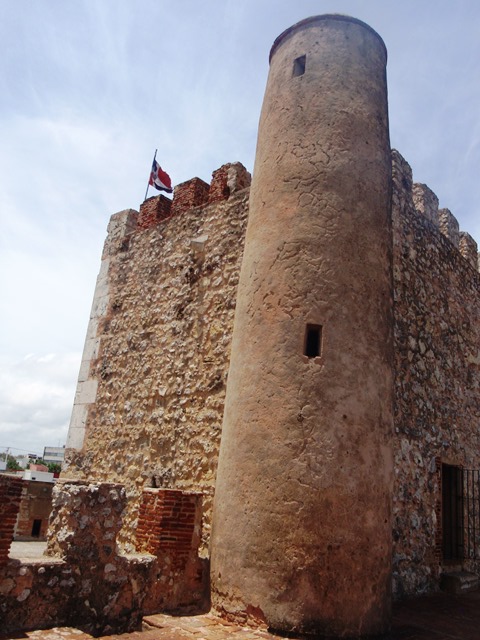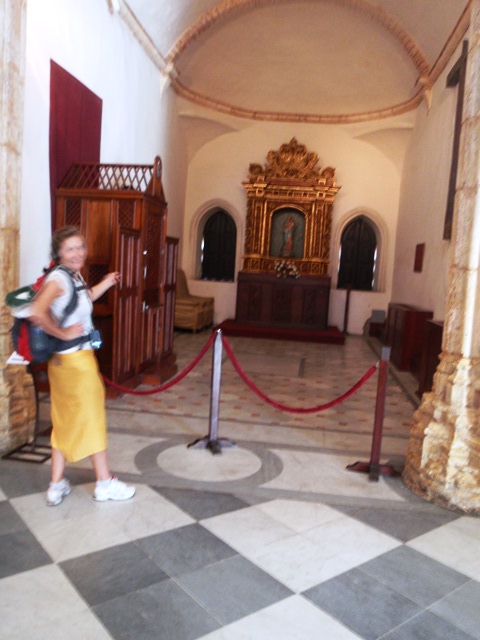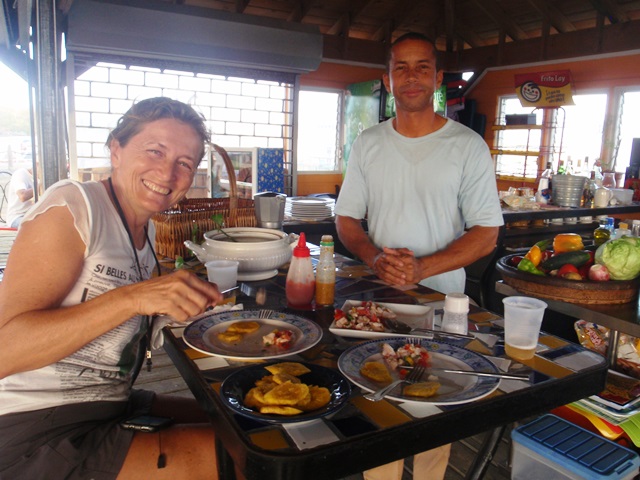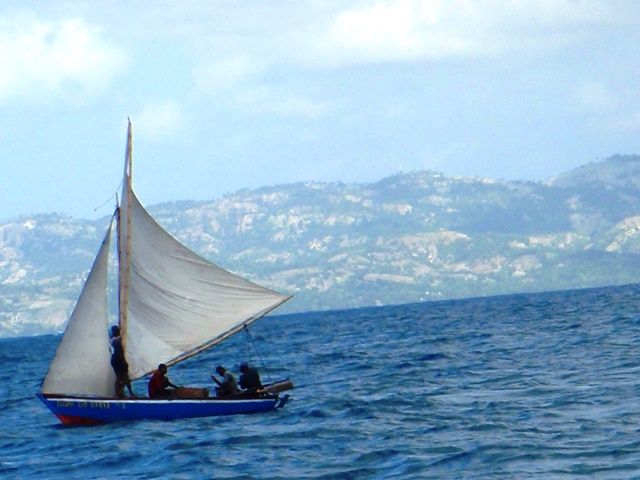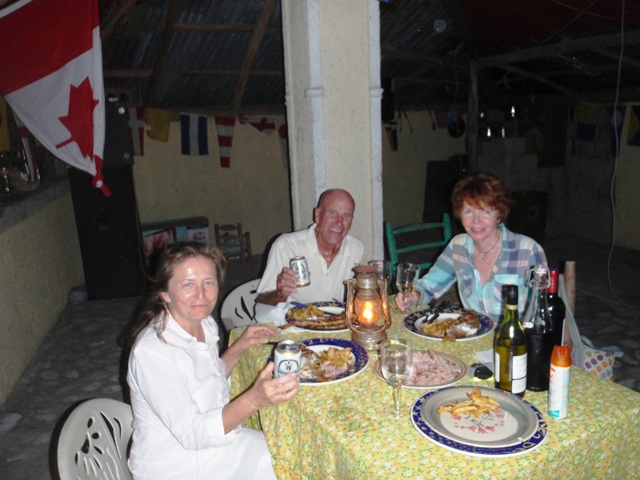Dominican Republic and Ile-a-vache
There are many stories about corruption and bribery in the Dominican Republic so we decided to play it safe to start with and check into the country at a respected marina, marina Zarpar. Our guide book and the general cruiser's information web site, noonsite.com had the total cost of check in, customs, immigration, permits etc at $64. At marina Zarpar we were presented with their information sheet requiring a "facilities fee" of almost $100 to access the customs, immigration and harbour master officers at the marina. Seems no matter what you do you get had one way or another! Of course it was late in the day and we had no option. A slip would cost $54 per day, a mooring, with access to all marina facilities, $19 per day, we took the latter as we wanted to visit the country's capital, Santa Domingo and we had heard of vessels being broken into in the small anchorage area. The bus service to Santa Domingo, via Boca Chica was surprising good, comfortable, reasonably clean, air conditioned, even with window curtains. Santa Domingo, well another city with restored 16th century fortifications, similarly aged and restored cathedral as well an abundance of shops.
We managed to find a sim card to give us data access on the phone but later found it to be extremely slow but at least enough to pick up email. In one of the street side restaurants we saw someone eating what looked like local fare, slow cooked chicken, beans , rice and salad, we should give it go. Out was truly delicious and with a 650ml beer, a whole $10. On the way back we got off the bus at Andreas to have a look at the village and take a couple of kilometre walk back to the marina. Not a good move, very dirty with the land along the side of the road used by the locals as a rubbish tip, it stank. Back in the marina we decided to leave the next day. In the Dominican Republic you must get a dispatch document from the coast guard, a “despacho”, to allow you to sail to the next port. If you stop off on the way to an anchorage that is not a port and the coast guard come along you have to say you had engine trouble or were too tired to continue, you need to have some excuse then, apparently it is OK. Anyway we had to find the marina harbour master, Raul, a very helpful guy, to arrange our “despacho”. It started to rain so we took shelter at the small tiki style marina bar restaurant and ordered a beer. Some guys had been out fishing and caught a few Mahi Mahi. The chef wanders over to the guys and selects a lovely fillet, returns to the restaurant where the kitchen is open on full view of all patrons, and proceeds to make a fantastic ceviche. We watched, enthralled, what job he did. Then, after he dished up to people that had apparently ordered, asked if we would like some so we had beautiful ceviche and fried plantain for dinner.
Two gastronomical delights in one day. Raul arranged our “despacho” for 6 the next morning after telling us we were only permitted to leave any port in the Dominican Republic between the hours of 6am to 6 pm, why? That's the law. The law here. We got our “despacho” at 6:30 the next morning and set of for the 60 mile sail to La Salinas as we had decided to stop off at a couple of spots along the cost instead of doing one long leg to Cuba. With very light winds behind us we had to motor much of the way and still no fish. Salinas is tucked into a fairly large bay, completely protected from the Caribbean swell although, for some unknown reason the anchorage is quite windy. No sooner had we dropped the anchor when a local coast guard representative came out in a commandeered fishing dinghy to check us. Speaking only Spanish, he clambered on board to "search" us and took our “despacho”. In the process depositing sand everywhere from his boots. Next he asked about alcohol, at first I thought he was asking if we had any on board but no he wanted alcohol, he got a very firm no, out of the goodness of my heart he got a small kangaroo key ring! On shore was very little, a few local fishermen a salt works with ponds covering a few hectares, worked mostly by hand with a barely operational tiny railway employing little trolleys of about one cubic metre to transport the salt. One tourist hotel with a jetty where we tied out dingy, staff were very friendly and helpful. The main Street has a number of restaurants, one seemed popular with locals so we had local fare with a large beer for 300 pesos ($7.50). It was so good we went back again the next night. Unfortunately we could not get an international “despacho” to go direct to Cuba here so had to get one to a port than could provide one, the nearest, in our generally Westward direction being Barahona 30 miles away. We set sail about 8 on the morning of 10 April managing to sail most of it almost straight down wind arriving in Barahona early afternoon to anchor in the calm basin in front of the Club Nautico (local yacht club). Almost immediately some guys on shore were waving and yelling to us, maybe we'd anchored in the wrong place so I went shore to find out. Three guys wanted to come out to Ednbal, one in uniform, coast guard, one immigration and one customs. They did the usual "search" and then the customs guy, who spoke some English, said the immigration guy would stamp our passports to exit the country for $50 each. We nearly freaked, everything has been paid for at Zarpar, well and truly. Luckily we still had an operational phone so called Raul at Zarpar. He must have given the immigration guy what for because he backed off very quickly. Our passports were stamped, no cost, and I took the three of them back to shore. We had a few things to get, international “despacho”, diesel and fruit and veg. First stop coast guard, we also took our 4 jerry cans in the dingy with us. A good start, our “despacho” would be ready at 17:30. Diesel available from the gas station at the other end of town, a long walk but a guy on a motor bike would take our jerry cans and fill them for $5, a good deal, saves a lot of walking. Now for fruit and veg. En route to the local market was a very well stocked bakery, just couldn't resist. By five we were back at the dingy packed, apparently our international “despacho” would be at Club Nautico at 17:30. I was there just after the agreed time and waited, at 18:30 a guy turned up on a motor bike waving a piece of paper but he wanted to deliver it to our boat. On Ednbal I signed for delivery then the guy wanted money, but no, there is no cost for “despacho”. Back on the phone to Raul. Turns out the guy wants $20 because he delivered the “despacho”. We could have easily picked it up from the coast guard office just a short dingy ride away. I gave our left over pesos, about ten bucks worth but he wanted more. After much gesticulating I have another $5 that was it. We finally managed to get him into the dingy and back to shore. We left at first light the next morning sailing South West to Cape Beata. A couple of hours later off screamed the reel, our first strike in well over a thousand miles of trawling. Alas I lost it. A couple of hours later, again. This time a big Mahi Mahi kept out of the water behind us but we had trouble trying to turn Ednbal fast enough to slow her down, the fish got off, bugger. We decided to sail down past the cape and come up in the lee of Island Beata to anchor for the night. As we were sailing West, on the Southern side of the island another strike. Have no idea what it was but it was big, took almost all my new 22kg braided line which ended up breaking at the reel, so still no fish and now no line either, double bugger! An hour or two later we were anchored a couple of hundred metres off the beach in beautiful clear water with just a few fishermen's huts and boats on the shore. Just before dark another yacht, a big aluminium Danish registered schooner, anchored not far from us, what a beautiful spot, could stay here a while. In the morning we went for a swim, wonderful to be in clear water with fish, a school of whiting, two stingrays, a big barracuda, a moray eel and a lot of other smaller tropical fish. After reviewing the weather information downloaded to the PC we decided we had to continue 140 miles to the next stop Ile La Vache, an island off Haiti in order pick up reasonable winds for the trip, 180 miles to Cuba. The sail to Ile La Vache was straight down wind in 15 to 25 knots, a very easy, if not roly, sail with just the headsail up averaging over 5.5 knots. Arrival however was not quite so due to the huge number of fish trap making buoys and almost as many local working sailing boats coming from the mainland checking their catch. Marking buoys consisted of two, three, four small plastic drink bottles tied to thin lines, very difficult to see. We weaved in and out of them on headsail, dodging the fishermen as we went, very tricky.
As soon as we entered the anchorage bay we had locals paddling along side us in dugout canoes welcoming and "wanting to help". Once the anchor was down we were almost swarmed even though there were half a dozen other yachts anchored. We son learnt that although they kept saying they wanted to do some work on the boat, polish, clean etc they were more after any sort of hand out. Now Haiti is a very poor country so you can understand, but it was difficult as locals just would not leave us alone, seems that every newcomer goes through the same thing. I selected one young guy, Bernard, to help me polish the topsides. Speaking some English (Haiti is Creole and French speaking) he proudly informed me it was his profession! Well it wasn't, I ended up doing most of the cleaning and polishing. There was another Aussie flagged yacht so we went over to say hello, on board was owner skipper Maurine whom we last saw in Guanaja, Honduras 5 years ago, what a small world indeed. A lot of catching up to do over a few beverages!
We also meet four Americans on two yachts traveling our way and tentatively arranged to meet up in Cuba. One of the main reasons for stopping off in Ille La Vache was to donate stuff, clothes, medications etc to an orphanage we'd heard about ran by a Canadian nun. We dinghied the few miles around to the small village and with some local guidance found the orphanage. What a short sight. Fran, the nun, takes in mostly mentally and physically disabled children, picked up by police after being left on the streets abandoned by their parents. Many were in wheelchairs, some crawled or walked on the bare floors. We had short chat and left the couple of bags of stuff we had bought after being assured that anything would be made good use of. We sailed out on Monday 15 April for the 180 mile trip to Santiago del Cuba, our Cuba check in Port enjoying a lovely aft quarter South Easterly breeze until the last fifty miles when the wind died out and on came the iron spinnaker.


